Discover 35 hidden attractions, cool sights, and unusual things to do in Valencia (Spain). Don't miss out on these must-see attractions: Ciutat de les Arts i les Ciències, Lonja de la Seda, and Queen Sofía Palace of the Arts. Also, be sure to include Principe Felipe Science Museum in your itinerary.
Below, you can find the list of the most amazing places you should visit in Valencia (Valencia).
Table of Contents
Ciutat de les Arts i les Ciències
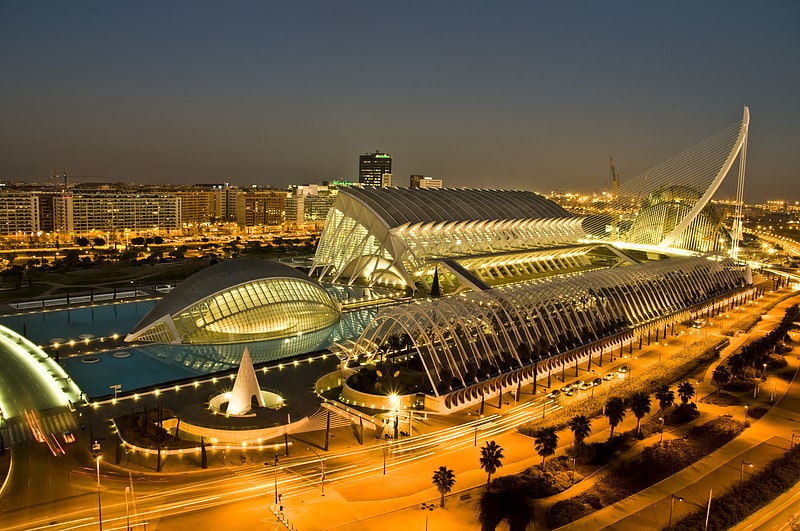
Also known as: Ciudad de las Artes y las Ciencias
State-of-the-art science and culture park. The City of Arts and Sciences is a cultural and architectural complex in the city of Valencia, Spain. It is the most important modern tourist destination in the city of Valencia and one of the 12 Treasures of Spain.
The City of Arts and Sciences is situated at the southeast end of the former riverbed of the river Turia, which was drained and rerouted after a catastrophic flood in 1957. The old riverbed was turned into a picturesque sunken park.
Designed by Santiago Calatrava and Félix Candela, the project began the first stages of construction in July 1996, and was inaugurated on 16 April 1998 with the opening of L'Hemisfèric. The last major component of the City of Arts and Sciences, Palau de les Arts Reina Sofía, was inaugurated on 9 October 2005, Valencian Community Day. The most recent building in the complex, L'Àgora, was opened in 2009.
Originally budgeted at €300 million in 1991 for three structures, it has expanded about three times the initial expected cost.[1]
Address: Av. del Professor López Piñero, 7, 46013 València (Cuatre Carreres)
Lonja de la Seda
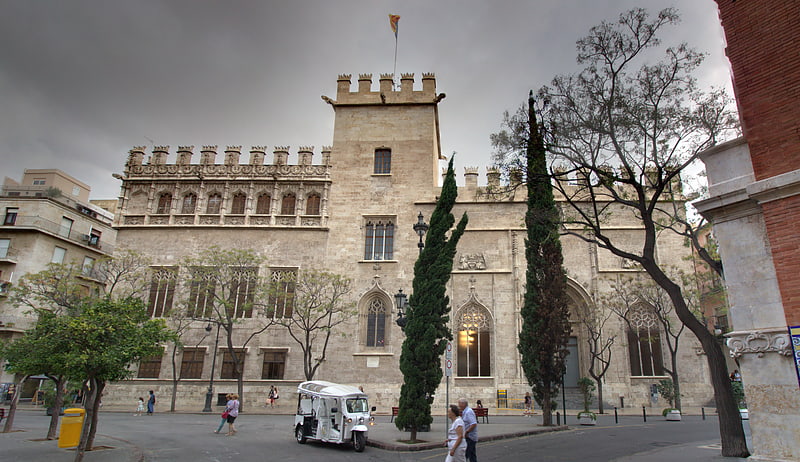
15th-century Gothic mercantile exchange. The Lonja de la Seda or Llotja de la Seda is a late Valencian Gothic-style civil building in Valencia, Spain. It is a principal tourist attraction in the city.[2]
Address: Plaza del Mercado, 46001 Valencia (Ciutat Vella)
Queen Sofía Palace of the Arts
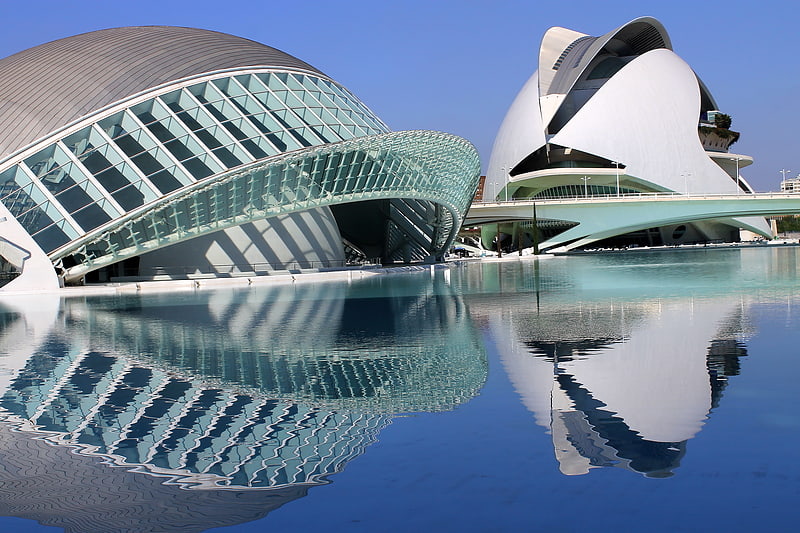
Also known as: Palacio de las Artes Reina Sofía
Contemporary venue for performing arts. Palau de les Arts Reina Sofía is an opera house, performing arts centre, and urban landmark designed by Santiago Calatrava to anchor the northwest end of the City of Arts and Sciences in Valencia, Spain. It opened on 8 October 2005; its first opera staging was of Beethoven's Fidelio on 25 October 2006. Tenor and conductor Plácido Domingo has maintained a special relationship with the Palau since its founding and has established a young singers training program there.[3]
Address: Av. del Professor López Piñero, 1, 46013 València (Cuatre Carreres)
Principe Felipe Science Museum
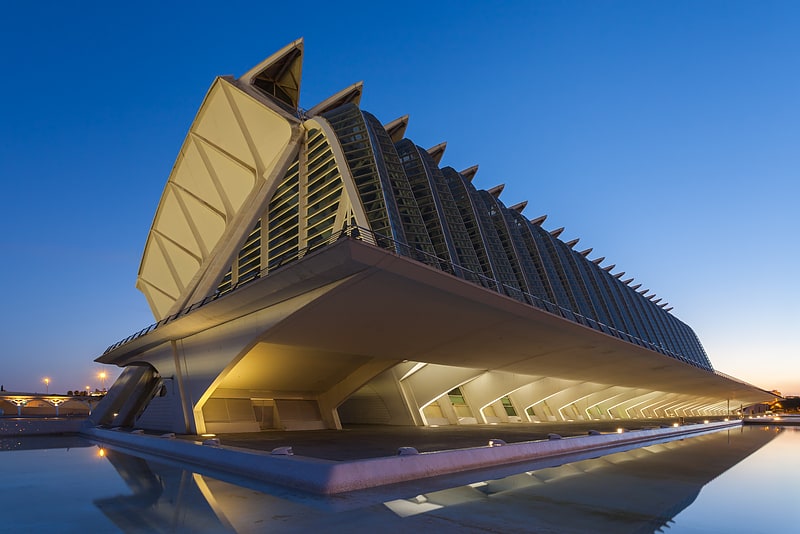
Also known as: Museo de las Ciencias Príncipe Felipe
Science museum with a sleek exterior. The Museu de les Ciències Príncipe Felipe is a science museum in Valencia, Spain. It is part of the City of Arts and Sciences, an architectural complex within the city and can be found at the end of Luis García Berlanga Street. Its director is Manuel Toharia, a Spanish science writer and television personality.
The building is over 40,000 square metres (430,000 sq ft), has a height of 55 metres (180 ft), and it resembles the skeleton of a whale, a façade that was designed by Santiago Calatrava and was built by a joint venture of Fomento de Construcciones y Contratas and Necso. Its construction started around 1994, it was symbolically inaugurated in March 2000 by Felipe VI, and it opened on 13 November 2000 with an investment of 26 million pesetas.
The purpose of the museum is to have interactive exhibitions and temporary collections related to science and technology without valuable items.[4]
Address: Av Profesor López Piñero, 7, 46013 Valencia (Cuatre Carreres)
L'Oceanogràfic
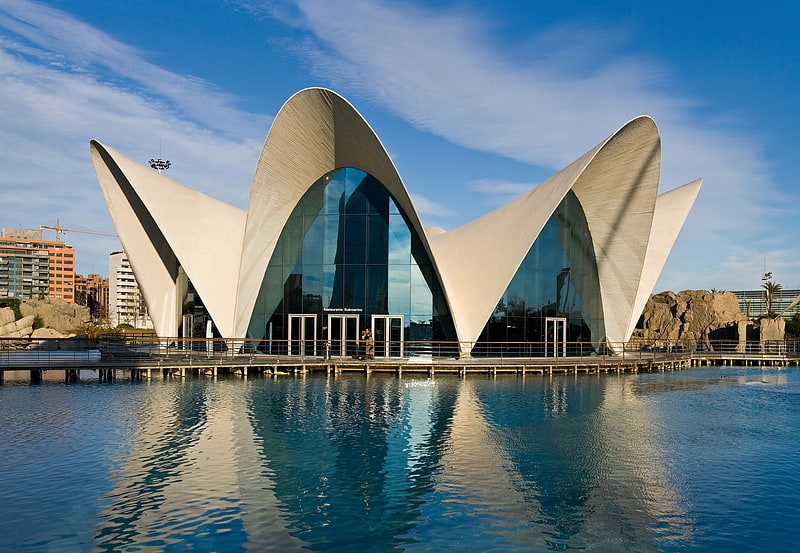
Also known as: Oceanogràfic
Huge aquarium with sharks and dolphinarium. L'Oceanogràfic is an oceanarium situated on the dry Turia River bed to the southeast of the city center of Valencia, Spain, where different marine habitats are represented. It was designed by the architect Félix Candela and the structural engineers Alberto Domingo and Carlos Lázaro. It is integrated inside the cultural complex known as the Ciutat de les Arts i de les Ciències. It was opened on 14 February 2003.[5]
Address: Carrer d'Eduardo Primo Yúfera, 46013 València (Cuatre Carreres)
Mercado Central

Restored market with over 1000 stalls. Mercado Central or Mercat Central is a public market located across from the Llotja de la Seda and the church of the Juanes in central Valencia, Spain. It is one of the main works of the Valencian Art Nouveau.[6]
Address: Plaça de la Ciutat de Bruges, s/n, 46001 València (Ciutat Vella)
Bioparc Valencia
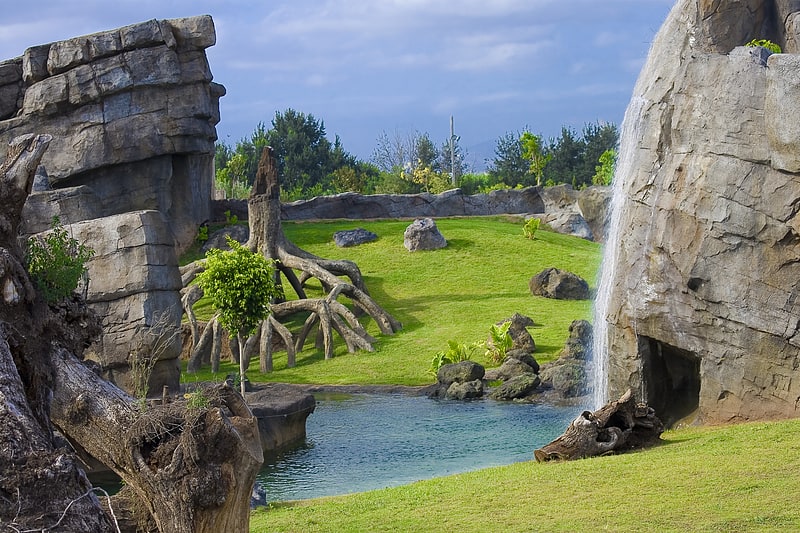
Wild animals in naturalistic habitats. Bioparc Valencia is a 10-hectare zoo park in Valencia, Spain. It is owned by the City Council of Valencia and designed and managed by Rainforest. It has a large collection of African fauna.
Located in Valencia's Turia riverbed, most of the animals moved to the new Bioparc facilities from the old city's zoo when the park opened in 2008.[7]
Address: Avenida Pio Baroja Escriptor 3, 46015 Valencia (Campanar)
Museu de Ciències Naturals
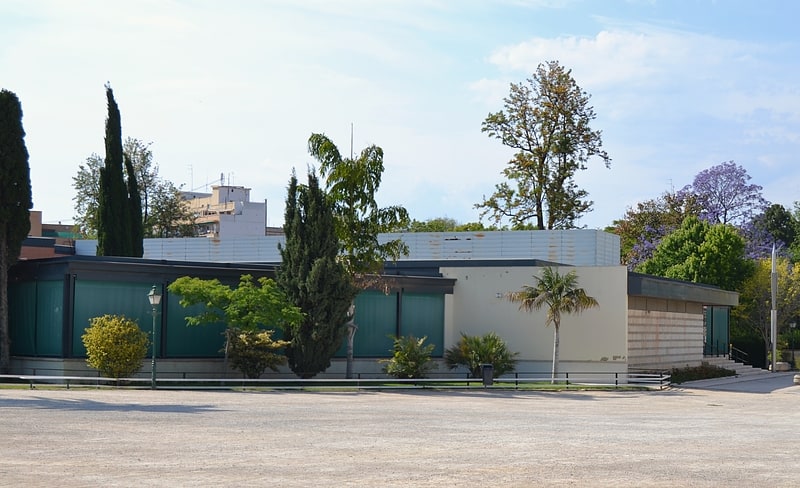
Museum in Valencia, Spain. The Natural Science Museum of Valencia is located at Jardines del Real.[8]
Address: Calle General Elio s/n, 46010 Valencia (La Saïdia)
L'Umbracle

Sculpture park under modern arches. L'Umbracle, part of the Ciutat de les Arts i les Ciències complex in Valencia, Spain, is a sculpture garden and landscaped walk with plant species indigenous to Valencia. It harbors in its interior The Walk of the Sculptures, an outdoor art gallery with sculptures from contemporary artists. The Umbracle is a space that is a home to numerous sculptures surrounded by nature. It was designed by Santiago Calatrava as an entrance along the south-western edge to the City of Arts and Sciences and as a cover over its car park. L'Umbracle was completed in 2001.[9]
Address: Rambla Saler 5, 46012 Valencia (Cuatre Carreres)
Museu de Belles Arts de València

Also known as: Museo de Bellas Artes de Valencia
The Museu de Belles Arts de València is an art gallery in Valencia, Spain, founded in 1913. It houses some 2,000 works, most dating from the 14th–17th centuries, including a Self portrait of Diego Velázquez, a St. John the Baptist by El Greco, Goya's Playing Children, Gonzalo Pérez's Altarpiece of Sts. Ursula, Martin and Antony and a Madonna with Writing Child and Bishop by the Italian Renaissance master Pinturicchio. It houses a large series of engravings by Giovan Battista Piranesi.
The museum is in the St. Pius V Palace, built in the 17th–18th centuries. It has also sections dedicated to sculpture, to contemporary art and to archaeological findings.[10]
Address: Calle San Pio V 9, 46010 Valencia (La Saïdia)
Botanical Garden of Valencia

Also known as: Jardín Botánico de la Universidad de Valencia
Botanical garden in Valencia, Spain. The Botanical Garden of the University of Valencia is a botanical garden located on calle Quart in El Botànic neighbourhood of Valencia, Spain. The garden depends administratively on the University of Valencia. It is a member of Botanical Gardens Conservation International.
The University was growing herbs for medicinal purposes as early as the 16th century. A botanical garden was projected from the mid-18th century, and the Garden opened on its present site in 1802. It remains a centre for study, education and public use.[11]
Address: Calle Quart 80, 46008 Valencia (Extramurs)
Valencia Cathedral
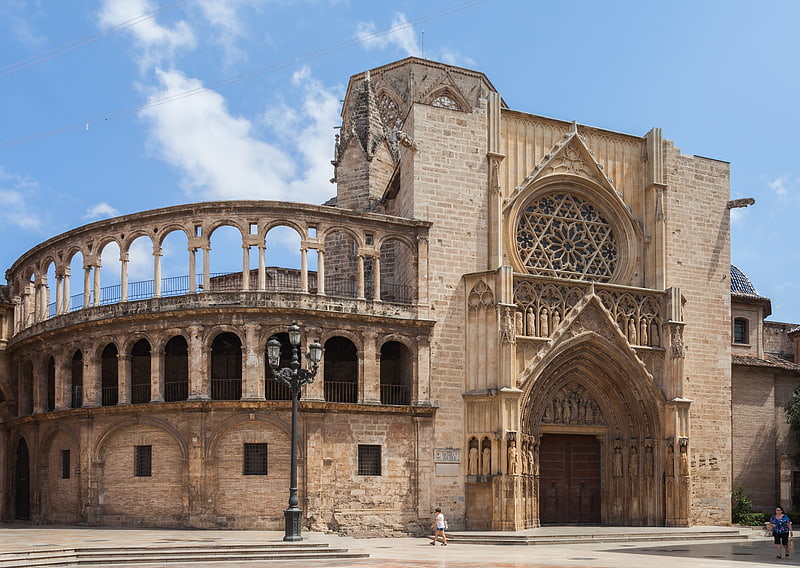
Also known as: Catedral de Santa María de Valencia
Landmark 13th-century place of worship. Valencia Cathedral, at greater length the Metropolitan Cathedral–Basilica of the Assumption of Our Lady of Valencia, also known as St Mary's Cathedral, is a Roman Catholic church in Valencia, Spain.
The cathedral was consecrated in 1238 by the first bishop of Valencia after the Reconquista, Pere d'Albalat, Archbishop of Tarragona, and was dedicated to Saint Mary by order of James I the Conqueror. It was built over the site of the former Visigothic cathedral, which under the Moors had been turned into a mosque. Valencian Gothic is the predominant architectural style of the cathedral, although it also contains Romanesque, French Gothic, Renaissance, Baroque and Neoclassical elements.
The cathedral contains numerous 15th-century paintings, some by local artists (such as Jacomart), others by artists from Rome engaged by the Valencian Pope Alexander VI who, when still a cardinal, made the request to elevate the Valencian See to the rank of metropolitan see, a category granted by Pope Innocent VIII in 1492.
A purported Holy Chalice, believed by many to be the true Holy Grail, is kept in one of the cathedral's chapels.[12]
Address: Plaza de la Reina, 46003 Valencia (Ciutat Vella)
Palacio del Marqués de Dos Aguas
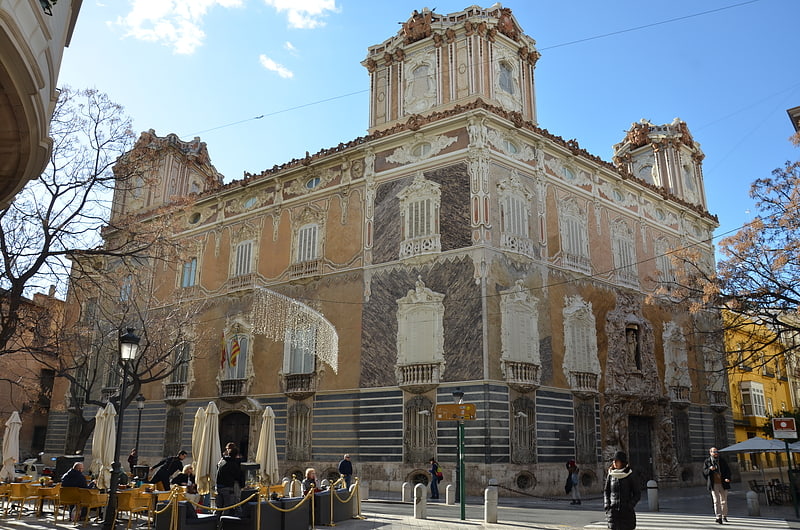
The Palace of the Marquis of Dos Aguas is a Rococo nobility palace, historically important in the city, is located in one of the most central locations in the city of Valencia, stately mansion that was of the Marqueses of Dos Aguas, currently owned by the Spanish State, where houses the González Martí National Museum of Ceramics and Decorative Arts.
A noble knight, Don Francisco Perellós, a descendant of the counts of Tolosa, married in the early 15th century to Joanna Perellós, only daughter of the wealthy Mosen Gines de Rabassa, the descendants of this marriage took the surname of Rabassa de Perellós. This family acquired by purchase the barony of Dosaigües in 1496, being elevated to marquisate by King Charles II of Spain in 1699.
Historians say, that the house of the Marqueses of Dos Aguas was considered in Valencia for centuries, as a paragon of nobility and opulence and that, its fortune came from the year 1500, at which time a family of merchants, the Rabassa, is enriched, first with the commercial treatment and then with the leases of the rights of the Generalitat Valenciana, i.e. the contracts of indirect contributions. The Rabassa de Perellós family continued their business with the Generalitat, while occupying high positions in the political government of Valencia and accumulated skills and important heredities through intermarriage with other important Valencian noble families.
The space in which it is located is believed that was probably originally the field intended to a Roman necropolis of the 1st and 3rd centuries, due to the findings in one of its courtyards on September 9, 1743.[13]
Address: Carrer del Marquès de Dos Aigües, 6, 46004 València (Ciutat Vella)
Plaça Redona
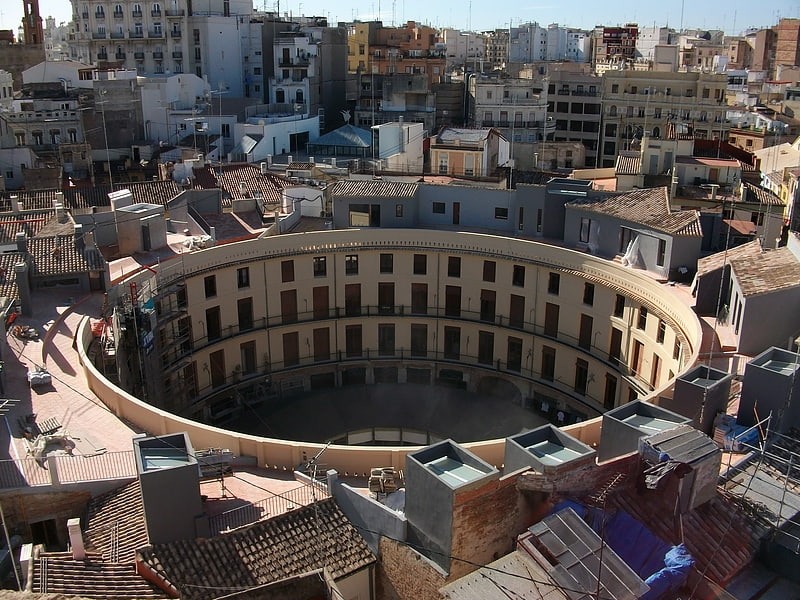
La Plaça Redona, also called Plaça del Clot is a plaza located in the El Mercat section of the Ciutat Vella district of Valencia, Spain. It lies in the middle of the triangle formed by three nearby plazas: La Plaça del Mercat, La Plaça de la Reina, and La Plaça de l'Ajuntament.
Motorized traffic is not allowed[14]
Address: Plaça Redona, 13-15, 46001 València (Ciutat Vella)
Torres de Serranos
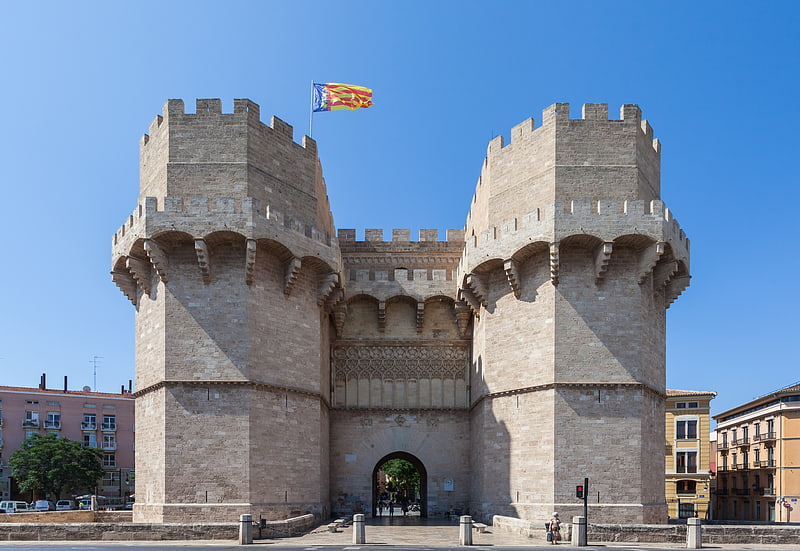
City views from monumental 1392 towers. The Serrans Gate or Serranos Gate, also known as Serrans Towers or Serranos Towers is one of the twelve gates that formed part of the ancient city wall, the Christian Wall, of the city of Valencia, Spain. It was built in Valencian Gothic style at the end of the 14th century. Its name is probably due to its location in the northeast of the old city centre, making it the entry point for the royal road connecting Valencia with the comarca or district of Els Serrans as well as the entry point for the royal road to Barcelona, or because the majority of settlers near there in the time of James I of Aragon were from the area around Teruel, whose inhabitants were often called serrans by the Valencians. Alternatively, the gate may also have been named after an important family, the Serrans, who lived in a street with the same name.
It is an important landmark and one of the best preserved monuments of Valencia. Of the ancient city wall, which was pulled down in 1865 on the orders of the provincial governor Cirilio Amorós, only the Serrans Towers, the 15th century Quart Towers, and some other archaeological remains and ruins, such as those of the Jewish Gate, have survived. The Torres de Serrans were built in the 14th century, 1392, by Pere Balaguer. It was the main entrance to the city and it was originally built with a defensive function. From 1586 until 1887 the towers were used as a prison for nobles.[15]
Address: Calle Conde Trenor, 16, 46003 Valencia (Ciutat Vella)
Assut de l'Or Bridge

Also known as: Puente de l'Assut de l'Or
Cable-stayed bridge in Valencia, Spain. The Assut de l'Or Bridge is a white single-pylon cable-stayed bridge in the City of Arts and Sciences in Valencia, Spain, designed by Valencian architect and civil engineer Santiago Calatrava and completed in December 2008. The name l'Assut de l'Or is Valencian for the Dam of the Gold and refers to a dam that was located nearby, although locally it is referred to as El Jamonero or Pont de l'Arpa, Spanish: Puente del Arpa. Calatrava called it the Serreria Bridge.[16]
Institut Valencià d'Art Modern
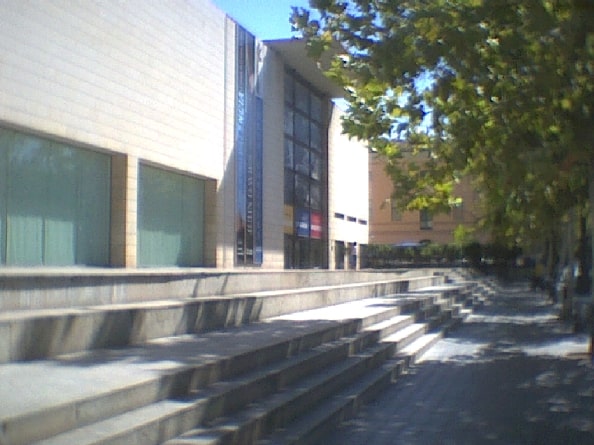
Also known as: Instituto Valenciano de Arte Moderno
Art institute in Valencia, Spain. The Institut Valencià d'Art Modern, also known by the acronym IVAM, was the first center of modern art created in Spain, opening in 1989 in the city of Valencia. The Institut Valencià d'Art Modern is an important center for modern and contemporary art in Spain and Europe. Nuria Enguita Mayo is the Director of the museum since September 2020.[17]
Address: Calle Guillen de Castro 118, 46003 Valencia (Ciutat Vella)
Valencia History Museum
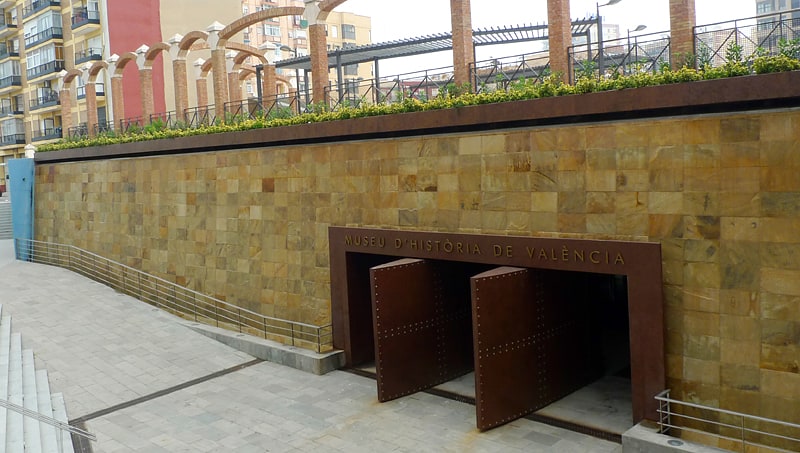
Also known as: Museo de historia de Valencia
Local history museum in an old reservoir. Valencia History Museum was inaugurated on May 7, 2003.
The mission of the Valencia History Museum is to educate visitors about the historical development of the city of Valencia. The MhV depicts the past of Valencia in an informative and entertaining way, using traditional exhibition resources and new technologies.[18]
Address: Carrer València, 42, 46920 Mislata (L'Olivereta)
Platja de Pinedo
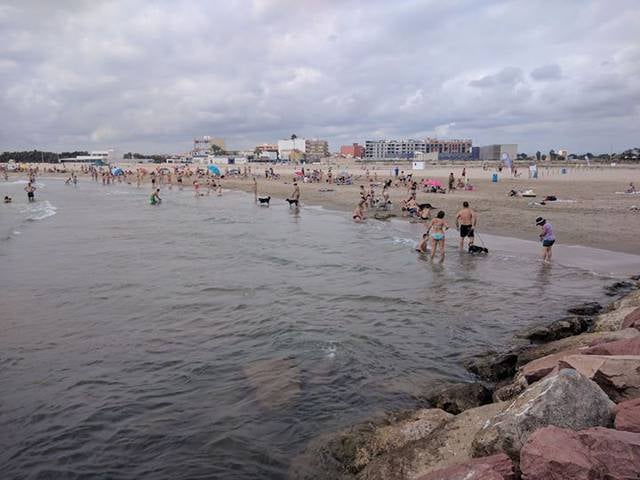
Beach
Address: Camí de Montañares, 46024 Pinedo (Pobles del Sud)
Estadi Ciutat de València

Also known as: Estadio Ciudad de Valencia
Stadium in Valencia, Spain. Estadi Ciutat de València is a football stadium in Valencia and is the home ground of Levante UD. Built in 1969 and holding up to 26,354 spectators, it is the 23rd-largest stadium in Spain and the 4th-largest in the Valencian Community.
On 8 September 2014, the ground hosted Spain's first match of UEFA Euro 2016 qualification, a 5–1 victory over North Macedonia.[19]
Address: Carrer de Sant Vicent de Paul, 44, 46019 Valencia (Rascanya)
Pelayo trinquet

Also known as: Trinquete de Pelayo
The Pelayo trinquet is one of the most renowned trinquets courts of the Valencian pilota sport in Valencia. The most important Escala i corda competitions, such as the Circuit Bancaixa, have their final matches played there.[20]
Address: Calle Pelayo 6, 46007 Valencia (Extramurs)
González Martí National Museum of Ceramics and Decorative Arts
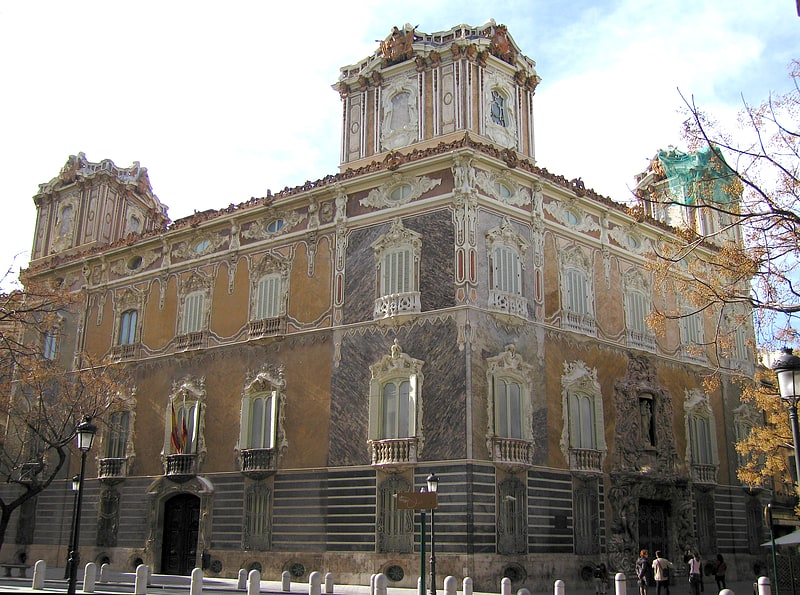
Also known as: Museo Nacional de Cerámica y Artes Suntuarias González Martí
Museum in Valencia, Spain. The National Museum of Ceramics and Decorative Arts "González Martí", located in Valencia, Spain, is a museum dedicated to ceramics, porcelains and other decorative arts such as textile art, traditional costumes and furniture.
Housed in the Palace of the Marqués de Dos Aguas, it was founded on 7 February 1947, from the donation of Manuel González Martí's ceramics collection. Seven years later, once the restoration of the palace was completed, the museum opened to the public on 18 June 1954.[21]
Address: Calle Poeta Querol 2, 46002 Valencia (Ciutat Vella)
Ayuntamiento de Valencia
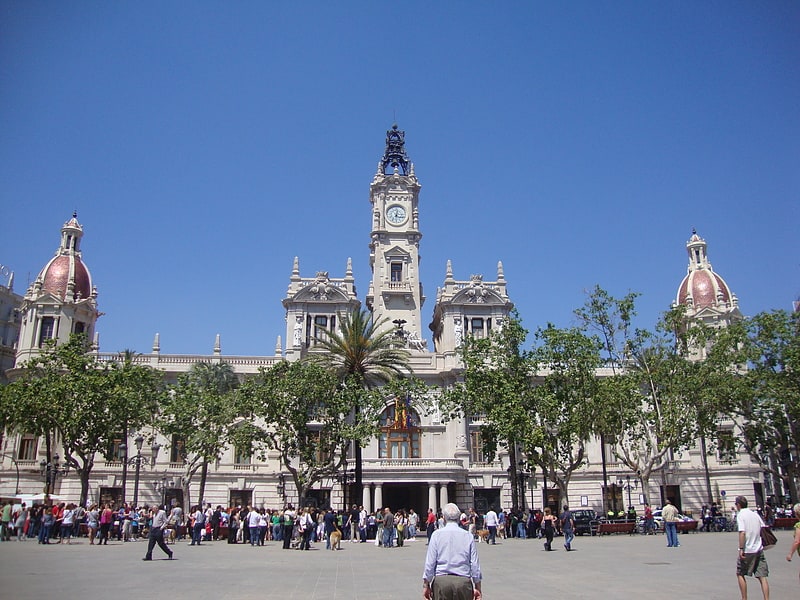
Also known as: Plaza del Ayuntamiento
Historical landmark in Valencia, Spain. The Modernisme Plaza of the City Hall of Valencia was the transformation of the square of the City Hall of Valencia by Javier Goerlich in 1931, now in its site is the current Plaza of the City Hall and its fountain.
Dr. Daniel Benito Goerlich (nephew of architect Goerlich Lleó), Professor of Art History and Curator of Cultural Heritage of the University of Valencia, states that the reform of the 1930s "belongs to a very specific social context, and was destroyed a few years later in a completely different context, the repressive postwar, towards the "disaffected" to the political regime of the time."[22]
Address: Pl. de l'Ajuntament, 1, 46002 Valencia (Ciutat Vella)
La Malvarrosa Beach
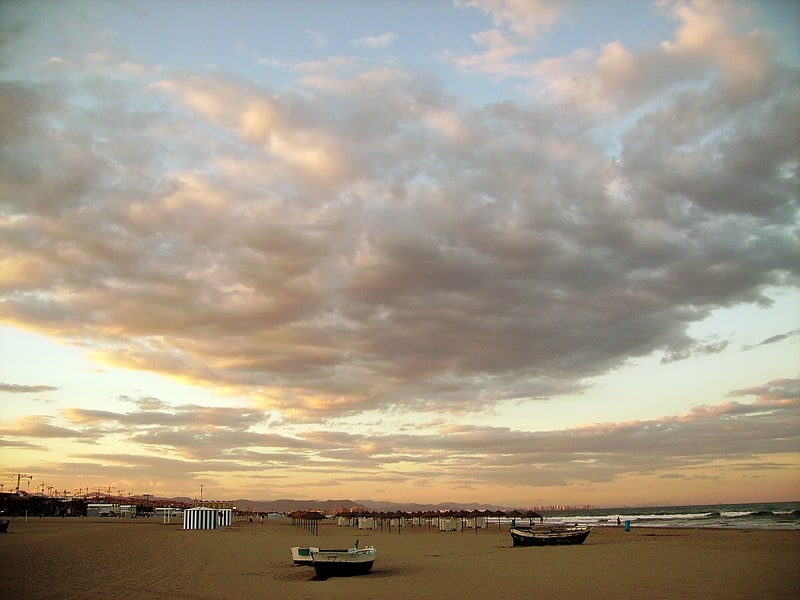
Beach
Address: Carrer de Pavia, 46011 Valencia (Poblats Maritims)
La Torre
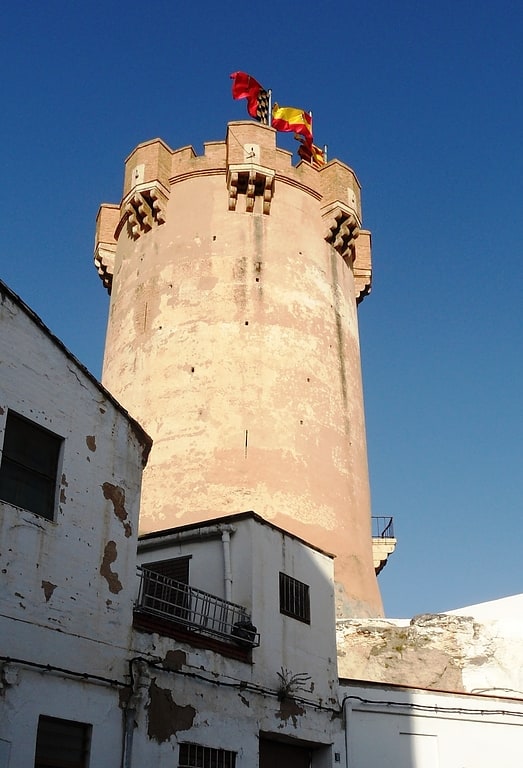
Also known as: Torre de Paterna
Archaeological museum in Paterna, Spain. The Tower of Paterna is a historical monument of the town of Paterna, in the province of Valencia, Spain.
It is the most emblematic monument of this valencian town. The origin of its construction is unknown, but it is thought that it was constructed during the Arab age, as a defense system to protect the city's inhabitants.
Today it is located in an urban park and is surrounded by earth houses excavated on the ground dating from the late 18th and early 19th centuries.
In 1971 it was declared a historic monument of local character and was adequately restored from former deterioration.[23]
Address: Carrer Coves de la Torre, 115, 46980 Paterna
Platja del Cabanyal - Les Arenes
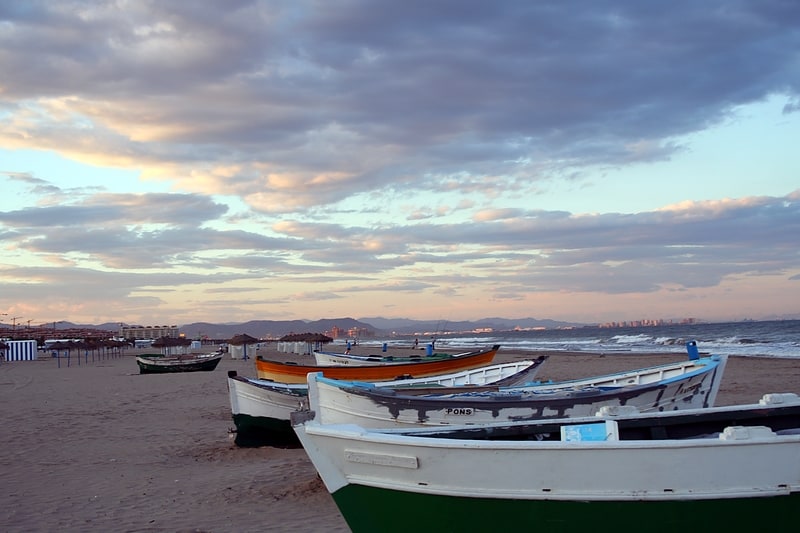
Playa del Cabañal is an urban beach of fine golden sand, located in the city of Valencia. It is bordered by an extensive promenade with numerous and spacious locals -former bathing houses- that offer a suggestive offer in accommodation and local gastronomy.
Address: Carrer de Pavia, 46011 Valencia (Poblats Maritims)
Museu Valencià d'Etnologia
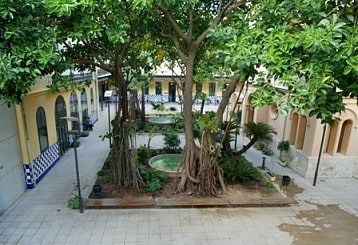
Also known as: Museo Valenciano de Etnología
Museum focusing on Valencian culture. The Valencian Museum of Ethnology is a museum located in the city of Valencia, mediterranean Spain. The museum mission defines it as cultural institution primarily devoted to collect, research and communicate the tangible and intangible heritage related to traditional and popular Valencian culture. The mission underlines that the museum also aims to permanently question fundamental aspects of the culture, as the dynamics that built it and force it to evolve, as well as its diversity. Although fundamentally devoted to Valencian cultural identity within a Mediterranean context, this museum also works to give visitors the chance to understand the challenges and dynamics of culture as a whole and from a contemporary perspective.[24]
Address: Calle Corona 36, 46003 Valencia (Ciutat Vella)
Monument to James I
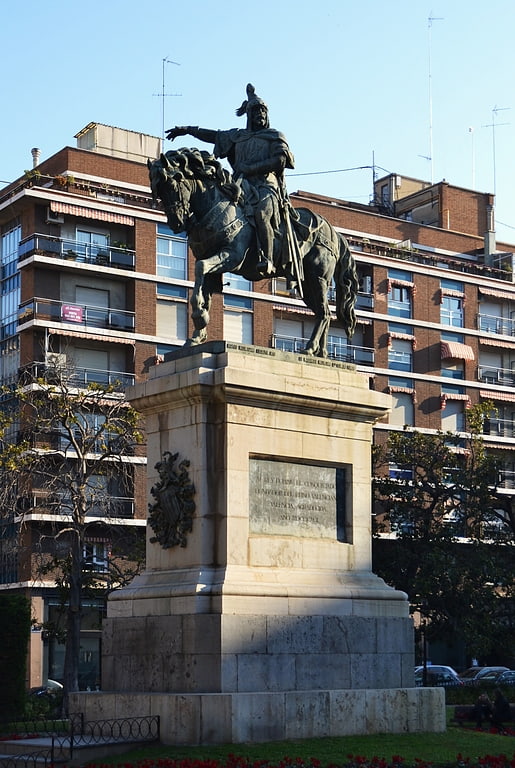
Jaume I or the Monument to James I is an instance of public art in Valencia, Spain. The monument is topped by a equestrian bronze statue representing James I of Aragon, conqueror of Valencia in 1238 and founder of the Kingdom of Valencia.[25]
San Esteban
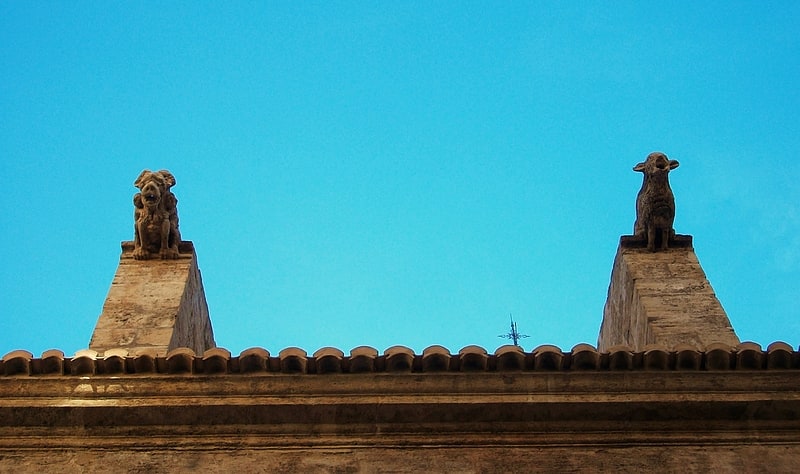
Parish church in Valencia, Spain. The Iglesia de San Esteban is a parish church located in Plaça de Sant Esteve in the city of Valencia, in the Valencian Community, Spain.[26]
Address: Plaza San Esteban 2, 46003 Valencia (Ciutat Vella)
Palau de la Música
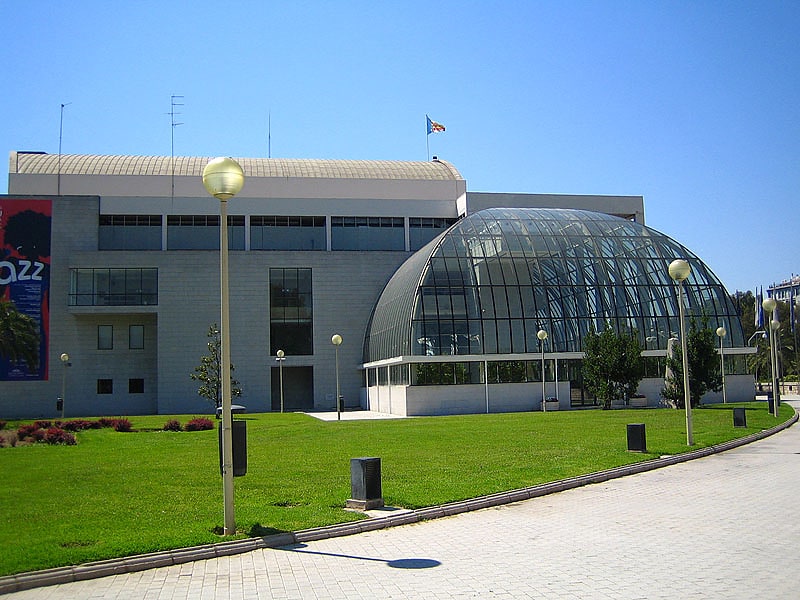
Personal trainer in Valencia, Spain. The Palau de la Música de València is a concert, cinema, arts, and exhibition hall in València situated on the Riu Túria. It is the home of the city's municipal orchestra, the Orchestra of Valencia founded 1943..[27]
Address: Passeig de l'Albereda, 30, 46023 Valencia (El Pla del Real)
Museu de Prehistòria de València
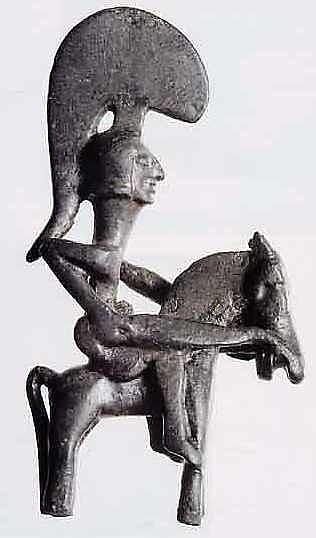
Also known as: Museo de Prehistoria de Valencia
Archaeological museum of local artifacts. The Prehistory Museum of Valencia is a museum of the city of Valencia that exposes archaeological materials covering from Paleolithic to the Visigoths period.
From 1982 it has been part of The Old House of Charity, built in 1841 which highlights the Byzantine style church built in 1881. The Font de Mussa Mosaic is one of the most highlighted pieces.
In 1995 began the complete restoration of the building, carried out by the architect Rafael Rivera. The House of Charity, now the Museum of Prehistory, has a ground floor and two stories arranged around five courtyards. On the ground floor are located the shop, cafeteria, two temporary exhibition rooms, workshops, warehouses and the Restoration and Quaternary Wildlife laboratories, as well as offices of the Prehistoric Research Service, while the Church has become the Hall. On the first floor are the Library and the Permanent Facilities dedicated to Paleolithic Neolithic and Bronze Age. On the second floor permanent galleries devoted to the Iberian culture and the Roman World.[28]
Address: Calle Corona 36, 46003 Valencia (Ciutat Vella)
Lladró Museum
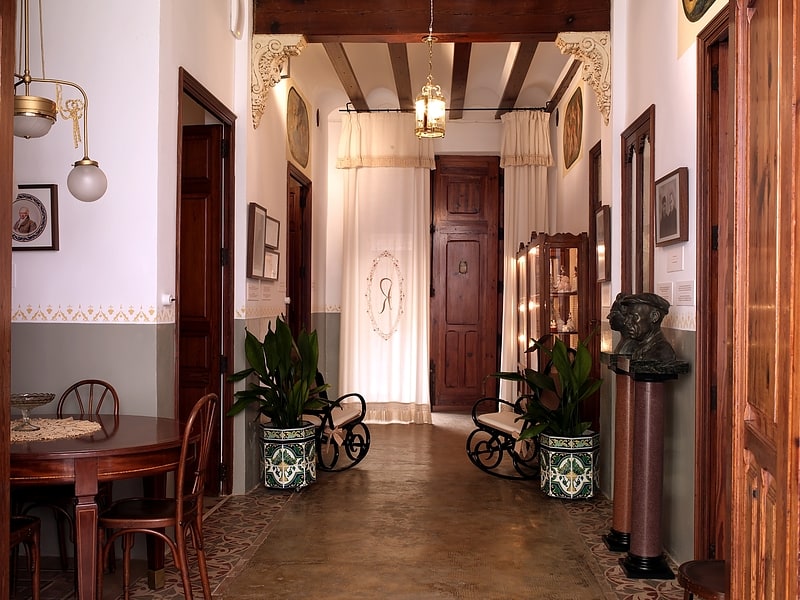
Also known as: Museo Lladró
Museum in Tavernes Blanques, Spain. The Lladró Museum is the family home of the Lladró brothers in Almàssera, a town close to Valencia, Spain, it has two permanent exhibits, the Historic Porcelain Museum and the Painting Collection. The family home is a typical Valencian house with exhibits of earlier artistic works, a patio with a Moorish kiln where its first porcelains were fired and installations where children can learn activities.[29]
Address: Ctra. de Alboraya, 46016 Tavernes Blanques, Valencia (Rascanya)
Real Colegio Seminario del Corpus Christi

The Real Colegio Seminario del Corpus Christi is a former Roman Catholic school and seminary founded in 1583 in the Spanish city of Valencia. It is located in calle de la Nau in the old city, opposite La Nau, the former Universidad Literaria.[30]
Address: Plaça del Col·legi del Patriarca, 6, 46002 València (Ciutat Vella)
Palacio de Benicarló

Museum in Valencia, Spain. The Palace of the Borgias is an aristocratic palace of Catalan Gothic and Renaissance styles located in the city of Valencia, Spain. It is now the headquarters of the Valencian Parliament.
The palace was constructed in the 15th century to be the residence of the Borgia family in the capital of the Kingdom of Valencia.[31]
Address: Plaza de San Lorenzo, Valencia, V, Valencia (Ciutat Vella)
Mercat del Cabanyal

Shopping, Market, Farmer's market
Address: C. Martí Grajales, 4, 46011 Valencia (Poblats Maritims)